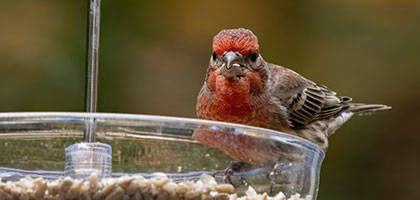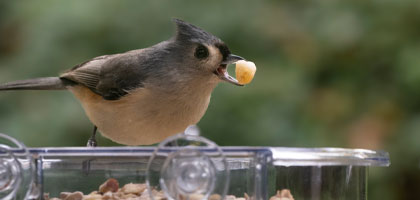Cardinals are a delight to watch. Their vibrant red plumage and melodic songs make them a favorite among bird enthusiasts.
But attracting these beautiful birds to your garden isn't always easy. It requires the right kind of bird feeder.
This guide will help you choose the best cardinal-friendly bird feeders. We'll explore various factors such as design, durability, and squirrel-proof features.
Whether you're a seasoned bird watcher or a beginner, this guide will provide valuable insights. You'll learn how to attract and feed cardinals effectively in your outdoor space.
Remember, the right feeder can make all the difference. It can turn your garden into a haven for these stunning birds.
So, let's dive in and discover how to choose the perfect cardinal-friendly bird feeder.
Understanding Cardinal Preferences
Cardinals have specific preferences when it comes to feeding. Understanding these needs can help you select the right feeder. Cardinals are ground feeders who favor feeders that provide easy access to seeds.
They are particularly attracted to certain seeds and colors. Here's a quick list of cardinal preferences:
- Seed types: Sunflower seeds, safflower seeds, and cracked corn.
- Colors: Bright red or similar shades that mimic their plumage.
- Feeder style: Platform and hopper feeders are ideal for their feeding habits.
By catering to these preferences, you can enhance your chances of attracting cardinals to your backyard.
Key Features of Cardinal-Friendly Feeders
When choosing cardinal-friendly bird feeders, consider several key features. These features ensure that the feeder meets the unique needs of cardinals while deterring other unwanted visitors, such as squirrels.
First, the feeder design is crucial. Cardinals prefer feeders that allow ample space for perching and feeding. Look for designs with large, sturdy perches that can support a cardinal's weight comfortably.
Cardinal feeders should have protective elements. Features like roofs or overhangs keep seeds dry, preventing spoilage. Clear materials are beneficial, making it easy to monitor seed levels and ensure a constant supply.
Some of the key features to look for include:
- Sturdy perches and ample feeding space
- Weather protection like roofs or overhangs
- Easy accessibility for monitoring and refilling seeds
These features make feeders more attractive to cardinals and enhance the feeding experience.
Feeder Types That Cardinals Love
Cardinals have preferences when it comes to feeder types. Some designs suit them better due to their feeding style.
Platform feeders offer a spacious area for cardinals to perch and feed. These feeders mimic their ground-feeding habits, making them an ideal choice. Hopper feeders are another excellent option. They provide seeds from an enclosed space while allowing cardinals to easily access and eat them.
Selecting the right type can significantly improve your chances of attracting these vibrant birds. Both platform and hopper feeders cater well to their needs, increasing your yard's appeal to cardinals.
The Importance of Feeder Material and Durability
The material of your feeder plays a vital role. It affects both durability and attractiveness for cardinals.
Choose materials that withstand harsh weather conditions. UV-stabilized plastic, metal, or recycled materials are excellent for longevity. These materials resist fading, warping, and other weather-related damage, ensuring the feeder lasts longer.
Durability also extends to protecting the feed. A strong construction prevents intrusions from animals and minimizes the wear and tear of daily use. This guarantees a steady supply of seeds for your feathered visitors. Durable materials contribute to both long-term reliability and cardinal attraction.
Size and Capacity for Cardinal Comfort
Size matters when selecting a feeder for cardinals. A feeder must be spacious enough for these medium-sized birds to perch comfortably while eating.
The capacity of the feeder is equally important. Ensure it can hold a sufficient amount of birdseed without frequent refills, as larger capacities cater to the cardinal’s appetite.
This balance of size and capacity helps accommodate a cardinal's needs effectively. It ensures that your feeder remains full while providing the comfort they seek, ultimately drawing more cardinals into your garden.
Squirrel-Proofing Your Cardinal Feeders
Protecting your cardinal feeders from squirrels is essential. Squirrels can quickly consume the birdseed meant for cardinals, leaving little to none behind. Implementing squirrel-proofing measures keeps the seeds available for your vibrant visitors.
Consider using feeders designed specifically to deter squirrels. These feeders often feature weight-activated mechanisms or baffle systems that restrict squirrel access. Such features ensure that only lighter birds like cardinals can reach the seeds.
Key squirrel-proofing features include:
- Weight-activated perch systems
- Baffles to block climbing access
- Locking lids to secure seeds inside
These features prevent squirrels from depleting the food supply, preserving your feeder for its intended guests.
Effective Squirrel-Proofing Techniques
Implementing effective squirrel-proofing strategies doesn't need to be complex. These techniques protect your feeders and encourage more cardinals to visit.
Start by placing feeders far from trees or structures. Squirrels use these as launch points to leap onto feeders. By maintaining a clear distance, you limit their access.
Adding a squirrel baffle, a device installed on poles or hangers, is also beneficial. This physical barrier prevents squirrels from climbing and reaching your feeders. Another method is using weight-sensitive perches, which close feeder access when heavier animals attempt to use them.
Combining these techniques significantly reduces squirrel interference, making your feeder a safe haven for cardinals.
Placement and Maintenance for Optimal Attraction
Positioning your cardinal feeders strategically is vital for success. Proper placement ensures cardinals have safe, easy access while discouraging predators.
Choose a site near natural shelter, like trees or shrubs. This setting provides cardinals with refuge and makes them feel secure.
Here are a few placement and maintenance tips:
- Avoid direct sunlight to prevent seed spoilage.
- Keep feeders at least five feet above the ground.
- Ensure clear views from your home's windows for enjoyable birdwatching.
Consistent maintenance also enhances attraction. Routine cleaning maintains bird health and feeder longevity.
Ideal Placement for Safety and Visibility
Placing feeders wisely maximizes cardinal visits. Select an area visible to your feathered friends and easily observable from your home. Ensure feeders are away from windows to prevent collisions and potential injury to birds.
Cleaning and Maintenance Tips
Regular cleaning of feeders prevents disease and debris buildup. Wash feeders every two weeks with warm, soapy water, and rinse thoroughly to remove any residue. Inspect feeder components regularly, replacing worn or damaged parts to ensure continual enjoyment for both you and the birds.
Additional Tips to Attract Cardinals
Enhance your garden's appeal to cardinals with a few simple strategies. Implement these additional tips to draw more vibrant red cardinals to your feeders:
- Offer a mix of sunflower and safflower seeds.
- Add a birdbath for hydration and bathing.
- Plant native shrubs for natural food sources.
These small steps create an inviting environment, increasing the likelihood of regular cardinal visits to your yard.
Conclusion: Creating a Cardinal Haven
Creating a welcoming haven for cardinals is deeply rewarding. By selecting the right bird feeders and taking a few extra steps, you'll enjoy these beautiful birds in your garden. Equip yourself with the knowledge from this guide and embark on a joyful birdwatching journey.






